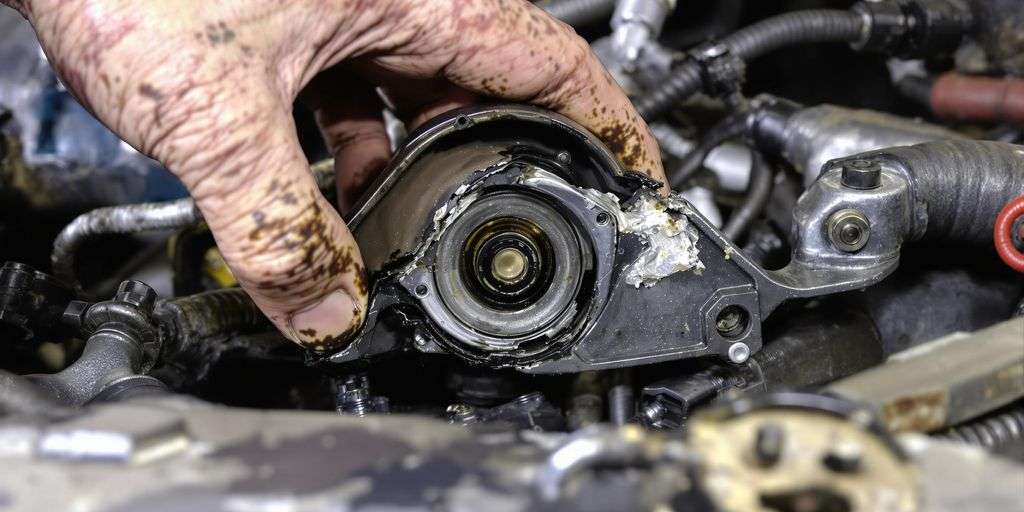Key Takeaways
- Understand the symptoms and effects of a broken engine mount before listing your car for sale.
- Decide whether to repair the engine mount or sell the car as-is based on cost and convenience.
- Clean your car thoroughly and gather all necessary documents to make a good impression on buyers.
- Research the market to set a competitive price, factoring in repair costs if applicable.
- Use online listings and social media to reach potential buyers and be transparent about the car's condition.
Understanding the Challenges of Selling a Car with a Broken Engine Mount
Identifying the Symptoms of a Broken Engine Mount
Spotting a broken engine mount isn't always straightforward. Listen for unusual sounds like clunking or banging when you accelerate or decelerate. These noises often signal that the engine is shifting more than it should. You might also notice excessive vibration when the car is idling. This happens because the engine isn't held securely in place. Look for visible signs too, like cracks in the rubber or metal parts of the mount.
Assessing the Impact on Vehicle Performance
A broken engine mount can seriously mess with your car's performance. The engine might move around too much, leading to problems with the alignment of other parts. This can cause issues like misfiring or even damage to the exhaust system. In severe cases, it might affect how the car handles on the road, making it feel less stable, especially during turns.
Evaluating Repair Costs vs. Selling As-Is
Deciding whether to fix the engine mount or sell the car as-is can be tricky. Repair costs can vary, but they often range from $200 to $600 depending on the make and model. If your car has other issues or isn't worth much, selling it with the broken mount might make more sense. On the other hand, fixing it could attract more buyers. Consider these options:
- Repair and Sell: Fix the mount to potentially increase the car's value and appeal.
- Sell As-Is: Skip the repair and sell the car at a lower price, appealing to buyers looking for a project.
- Trade-In: Consider trading the car in at a dealership, which might offer a reasonable deal despite the mount issue.
Weigh the repair costs against the potential selling price to make the best decision for your situation.
Preparing Your Car for Sale: Essential Steps
When you're ready to sell your car, especially one with a broken engine mount, getting it in the best possible shape can make a big difference. Here are some essential steps to follow:
Cleaning and Detailing Your Vehicle
First impressions matter a lot, especially when selling a car. A clean car can significantly boost its appeal to potential buyers. Start by giving your vehicle a thorough wash, both inside and out. Vacuum the interior, wipe down surfaces, and don't forget the windows. A little polish can make your car shine and look well-cared for. It's worth considering a professional detailing service if you want to make the car truly sparkle.
Gathering Necessary Documentation
Having all the right paperwork ready is crucial. Gather your car's title, service records, and any warranty information. If you've had any recent repairs or replacements, make sure to include those receipts as well. This not only builds trust with buyers but also shows that you've taken good care of your vehicle.
Highlighting the Car's Features and Benefits
Even with a broken engine mount, your car has its strengths. Make a list of features that stand out, like fuel efficiency, a sound system, or recent upgrades. Be honest about the car's condition but focus on what makes it special. You might also want to mention any extras, such as a new set of tires or any included accessories.
Preparing your car well not only attracts more buyers but can also help you sell it at a better price. Taking the time to clean, organize paperwork, and emphasize the car's positive aspects can set you apart in a competitive market.
By following these steps, you'll be setting yourself up for a more successful sale. Remember, the effort you put into preparing your car can pay off when it comes time to negotiate with buyers. For more tips, check out our guide on taking high-quality photos to showcase your vehicle effectively.
Setting the Right Price for Your Car

Researching Market Value
Selling a car with a broken engine mount can be tricky, especially when it comes to pricing. Start by checking out similar cars in your area. Look at online listings and local classifieds to get a feel for prices. Don't forget to factor in the condition of your car compared to others. Not all cars are equal, and neither are their prices.
Considering the Cost of Repairs
Before setting a price, think about how much it would cost to fix the engine mount. On average, engine mount replacement can run around $500, mostly for labor. Would fixing it make your car more attractive to buyers? Or would it be better to sell as-is and let the new owner handle it? Weigh the costs and benefits carefully.
Negotiating with Potential Buyers
Once you've set a price, be ready to haggle. Buyers might try to knock down your price, especially knowing about the engine mount issue. Be upfront about the problem and use it as a bargaining chip. Highlight any positives your car has, like a clean interior or recent maintenance, to balance the conversation.
Pricing a car with issues like a broken engine mount isn't just about numbers. It's about understanding your car's worth and making sure potential buyers see it too.
Marketing Strategies to Attract Buyers

Crafting an Effective Online Listing
Creating a standout online listing is key when selling a car with a broken engine mount. Highlight the positives—mention features like a recent paint job or new tires. Be upfront about the engine mount issue, but also emphasize the car's potential. Use clear, high-quality photos; they can make a big difference. Make sure to include all the essential details, like mileage, make, and model.
Utilizing Social Media Platforms
Social media is a powerful tool for reaching a wide audience. Share your listing on platforms like Facebook Marketplace and Instagram. Join local car groups and forums to spread the word. Post regularly but don’t spam. Keep your posts engaging and interactive to draw interest. Use hashtags related to your car’s make and model to increase visibility.
Engaging with Local Car Enthusiast Groups
Getting involved with local car enthusiast groups can help you find a buyer who appreciates your car, even with its issues. Attend local car meets or events and talk to people who might be interested. These groups often have members looking for project cars or specific parts. Building connections in these communities can lead to quicker sales.
Selling a car with issues can be challenging, but by tapping into the right networks and presenting your vehicle honestly, you can turn what seems like a setback into an opportunity.
Using these strategies, you can transform your non-running car into cash and find the right buyer who sees the potential in your vehicle.
Navigating Legal and Financial Considerations
Understanding Disclosure Requirements
When selling a car with a broken engine mount, it's crucial to be upfront about the car's condition. Honesty is not just ethical but legally required in many places. Failing to disclose known issues could lead to legal trouble down the road. Make sure you document everything, so buyers are fully aware of what they’re getting into.
Handling Title Transfers and Paperwork
Transferring the title of a car can be a bit of a hassle, especially if you're unfamiliar with the process. You'll need to complete the necessary paperwork to officially transfer ownership to the buyer. This often includes signing the title over, completing a bill of sale, and sometimes a release of liability form. Double-check with your local DMV to ensure you're following all the right steps.
Exploring Financing Options for Buyers
Some buyers might need help with financing to purchase your car. While you might not be a bank, you can still assist by suggesting possible options. Encourage buyers to explore personal loans from their bank or credit union. Additionally, some online platforms offer car loans specifically tailored for used car purchases. This can make your car more appealing to a wider audience.
Alternative Options: Trading In or Donating Your Car
Thinking about trading in your car with a broken engine mount? It's a common option and could be a good move if you're looking for a quick transaction. When you trade in your car, the dealer assesses its value, which might be lower due to the engine mount issue. It's important to do your homework and get quotes from multiple dealerships to ensure you're getting a fair deal. Remember, dealers will factor in the cost of repairs, so the offer might not be as high as you'd hope.
Donating your car is another route, especially if the trade-in offer isn't appealing. When you donate, organizations often handle towing, and your car could be sold at auction or for scrap. This not only helps a cause but might also give you a tax deduction. It's a win-win situation, particularly if the car isn't worth much in its current state. For more about how this process works, check out our section on donating an old vehicle.
If neither trading in nor donating sounds right, selling to a salvage yard or junk car buyer might be your best bet. These buyers are usually interested in the parts, so the condition of the engine mount might not impact the price as much. It's a straightforward process: get a quote, agree on a price, and they'll often tow the car away for you. Make sure to compare offers from different buyers to get the best deal.
Sometimes, letting go of an old car is more about moving forward than the money. Whether you trade it in, donate it, or sell it for parts, each option has its own perks and pitfalls. Ultimately, it's about what works best for your situation and peace of mind.
Tips for a Successful Sale Experience
Communicating Transparently with Buyers
When selling a car with a broken engine mount, honesty is your best policy. Buyers appreciate straightforward communication, especially about mechanical issues. Make sure to disclose all known problems and provide any repair estimates you might have. This builds trust and sets realistic expectations.
Preparing for Test Drives and Inspections
Before anyone takes your car for a spin, ensure it's safe to drive, even with the engine mount issue. It might be wise to have a mechanic check it over first. During test drives, encourage potential buyers to focus on other aspects of the car, like comfort and handling. Be prepared for inspections and have all relevant service records ready.
Finalizing the Sale Securely
Once you've found a buyer, it's time to wrap things up. First, make sure all paperwork is in order, including the title and any necessary transfer documents. Consider meeting at a bank to handle the payment securely. If you're accepting a cashier's check, verify its authenticity with the issuing bank before handing over the keys.
Selling a car with issues can be tricky, but with transparency and preparation, you can ensure a smooth transaction.
To get an idea of what your car might be worth, even with its issues, it's helpful to evaluate your car's worth by researching similar vehicles on the market.
Wrapping It Up: Selling Your Car with a Broken Engine Mount
So, there you have it. Selling a car with a busted engine mount isn't the end of the world. Sure, it might seem like a hassle at first, but with the right approach, you can still make a decent sale. Whether you decide to fix it up a bit or sell it as-is, being upfront about the issue is key. Buyers appreciate honesty, and it can save you a lot of headaches down the road. Remember, every car has its buyer, even the ones with a few quirks. So, take a deep breath, weigh your options, and go for it. Who knows, you might even learn a thing or two about car sales along the way. Good luck!
Frequently Asked Questions
What are the signs of a broken engine mount?
A broken engine mount might cause the car to vibrate a lot, especially when you start or stop the engine. You might also hear clunking noises when driving.
How does a broken engine mount affect driving?
Driving with a broken engine mount can make your car feel shaky and unstable. It might also cause other parts of the engine to wear out faster.
Is it better to fix the engine mount before selling the car?
Fixing the engine mount might make your car easier to sell and could help you get a better price. However, if the repair costs too much, you might decide to sell the car as it is.
How can I set a fair price for my car with a broken engine mount?
To set a fair price, check how much similar cars are selling for and consider the cost to fix the engine mount. Be ready to negotiate with buyers.
What should I include in my car's online listing?
Include clear pictures of the car, details about its features, and be honest about the broken engine mount. Highlight any positive aspects, like new tires or a recent paint job.
What legal steps do I need to take when selling my car?
You'll need to disclose the broken engine mount to buyers, transfer the title, and handle any necessary paperwork to complete the sale.



